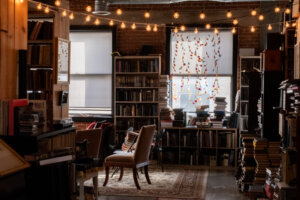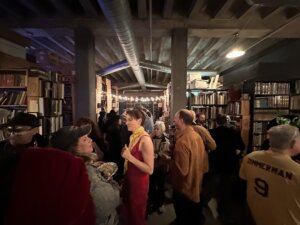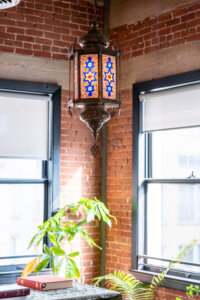Der Nister, the hidden shul on the 14th floor
Building a synagogue that embraces culture

Photo by Erik Aleman
The intersection of Spring and 7th in Downtown LA is the most mercurial corner of the most unpredictable city. Anything can happen, at any time.
At night, masses of partygoers flock to the clubs in the lobbies of old bank buildings, a row of them that was once called the Wall Street of the West. In the morning, the streets hum with workers rushing to their offices, street vendors setting up shop, movie crews assembling to film another blockbuster (sometimes flooding the streets with masses of tuxedoed men and ballroom-gowned women ready to shoot their period piece), and people blaring ‘90s rap music and ‘70s R&B on their massive boomboxes.
As the day rolls on, the unfortunate souls who live on the streets of Skid Row make their way through, some of them apparently just released from mental hospitals and illegally dumped there, judging by their wristbands, hospital gowns and occasional screaming. The police and fire vehicles blaze through, and you can’t be quite sure what they’re responding to. A nearby warehouse fire? An armed robbery? All the while, people continue to make their way to the corner stores and restaurants.
Some of them find their way to the LA Cafe, open all day and late into the night. This is not their destination but it’s the most visible marker to help find the entrance to another old bank building, built in 1919. Those who know the code or know where to ring, enter the lobby.
The building is 13 floors tall, but given the superstitions of yesteryear, there is no 13th floor. People take the one working elevator and press the button for the 14th floor. At the end of the hallway on top, there are posters and a wooden bookseller’s sign, marking Der Nister Downtown Jewish Center.

Stepping inside Der Nister is somewhat overstimulating by design. There are posters and paintings of different Jewish movements hanging on the walls. Above the door frame hangs a poster from the 1970s movement to free Soviet Jews, and nearby is a white flag with a rainbow-colored stripe, representing the Jewish Autonomous Oblast in Russia, where Yiddish holds semi-official status and a deep history. A small picture of Theodor Herzl adorns a bookshelf.
As you go further into the room, the bookshelves go on and on, filled with books in Hebrew, Yiddish, English and other languages about Jewish life and Judaism, including a Yiddish copy of Crime and Punishment (Farbrekhn un shtrof) coexisting with Torah commentaries. In the back of the room, a clearing opens up with a Turkish lamp and rugs, plants and a Torah ark — a lush room for prayer, surrounded by views of the surrounding brick buildings.
On the face of it, Der Nister doesn’t seem to have much to do with reality. But I can attest that it’s very real.

A friend of mine, Rabbi Henry Hollander, and I were both attending the Ziegler Rabbinical School in Los Angeles when I once proposed that we start our own synagogue. Henry, the proprietor of Hollander Books in San Francisco, a used book store specializing in Jewish books, wanted to move his collection down to Los Angeles where he lives anyway so that he would no longer need to travel to the Bay Area to attend to his business.
“Why not put the synagogue in the bookstore?” I asked. He agreed.
But first we needed a name. After fishing around, he suggested Der Nister, meaning The Hidden One in Yiddish. At the time, I didn’t know the Yiddish writer Pinchas Kahanovitch who bore this pseudonym, but I was familiar with Rabbi Nachman’s idea that God is hidden. And since we weren’t easily found on the 14th floor space that he rented for the books, I thought that name was appropriate.
And so we started in 2020, but did so online, since it was the beginning of the COVID pandemic. Henry painstakingly assembled the bookshelves, and I tried to work out the decor to give it a bit of a spiritual atmosphere.

Then we talked amongst ourselves, figuring out what we wanted. I recalled the trips I took in rabbinical school across Jewish communities in Europe and the Middle East. Everywhere I went, I saw that Jewish culture was intertwined with religion, which was a revelation to me.
I saw ornate synagogues, heard cantors sing the art of cantorial music — khazones, tried local Jewish foods like flódni in Hungary and sang Yiddish drinking songs with Birobidzhan native Ber Kotlerman while I was getting ready to teach young adults about Judaism in Russia’s Far East. Sharing the beauty of Jewish culture was new to me, because in Los Angeles, classic architectural and decorative ornamentation had been replaced by a plain boardroom aesthetic; khazones became a rarity, and having happenstance encounters with Jewish culture was hard to imagine.
I decided that our synagogue must be both a religious and a cultural center, a place that didn’t see Yiddish or Israeli culture as an afterthought. We wanted people to feel at home with the books that would surround them, the treasures of Jewish civilization.
Frustratingly, either because I could not articulate the concept, or the concept was very foreign, attempts to explain this vision fell largely on deaf ears. We would have to prove our concept before we could even imagine fundraising for it.
We started hosting small concerts, including one by Jeremiah Lockwood, a scholar of khazones, and held services on Shabbat mornings and during the High Holidays.
At first, people hesitated to come, even after the pandemic died down. Downtown, especially in 2021, was a foreboding place, known for a relatively high crime rate. As a result, the Shabbat morning daveners were often just Henry and me.
And then we got lucky. Filmmaker, theater director, and my one-time Hebrew tutor Ye’ela Rosenfeld, premiered her short film Hedgehog with us, about a nurse who has to care for an old man who committed Nazi atrocities.

This led to more productions of hers — memorably, a one-man show about Karl Marx, and a cabaret about Downtown, chock-full of Yiddish songs. She eventually became a rabbi as well, and joined Henry and me in leading Der Nister.
We also fielded a call from fiddler-composer Craig Judelman, who was touring the West Coast with the Yiddish singers Michael Alpert and Sasha Lurje — all world-class klezmer musicians who could fill a room. They needed somewhere to perform, and we were happy to oblige. The crowd streamed in.
We finally picked up enough steam to gather a community of concert-goers, local shul-goers, readers of our Friday newsletter and students of our Yiddish classes. After each event, people would hang around and talk.
It was gratifying to see that the world we had painstakingly created as volunteers was bringing people in.
But I know how much more work still needs to be done, especially on the fundraising and organizational side, which I had been learning on the fly. Becoming fully-funded is the ultimate dream, which would not only keep us going, but hopefully prove that there is a future for a synagogue that embraces our cultural treasures as well.
























